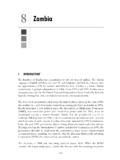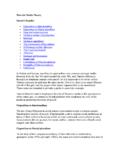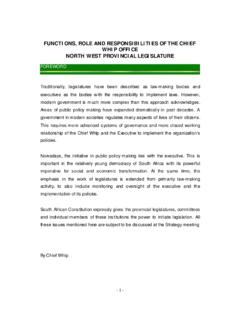Transcription of RETÓRICA POLÍTICA POLACA CONTEMPORÁNEA - Rétor
1 R TOR, 5 (2), pp. 192-210, 2015 192 CONTEMPORARY POLISH POLITICAL RHETORIC RET RICA POL TICA POLACA contempor NEA Agnieszka Kampka Warsaw University of Life Sciences (Polonia) Abstract The article discusses three dimensions of political rhetoric in Poland. The language used by politicians is the first one. Social and historic factors which conditioned contemporary styles of political communication result in the fact that political rhetoric in Poland is typical of countries which experienced authoritarian or totalitarian regimes. The second dimension of political rhetoric is found in media discourse. Mediatization of politics, technological changes in the media created a new rhetorical situation, new strategies of the persuasion used by politicians and journalists. The third dimension of political rhetoric is found in the rhetorical research concerning the ways of expression of both politicians and journalists.
2 The article discusses major tendencies in research: propaganda language analysis, research on the new media, visual persuasion as well as use of rhetoric as a tool of civic education. Keywords: political rhetoric political language Polish rhetoric media discourse. Resumen El art culo aborda las tres dimensiones de la ret rica pol tica en Polonia. La primera es el lenguaje de los pol ticos. Los factores sociales e hist ricos que condicionaron los estilos contempor neos de la comunicaci n pol tica hacen que la ret rica pol tica en Polonia sea t pica de pa ses que tienen detr s una experiencia de autoritarismo o totalitarismo. La segunda dimensi n de la ret rica pol tica es el discurso medi tico. La mediatizaci n de la pol tica, los avances tecnol gicos en los medios crearon una nueva situaci n ret rica, las nuevas estrategias del juego persuasivo entre pol ticos y periodistas.
3 La tercera dimensi n de la ret rica pol tica son los estudios ret ricos relativos a las declaraciones de los pol ticos y los periodistas. El art culo analiza las tendencias principales de la investigaci n, es decir el an lisis del lenguaje de la propaganda, los estudios acerca de los nuevos medios de comunicaci n, la persuasi n visual y el tratamiento de la ret rica como una herramienta de la educaci n c vica. Palabras clave: ret rica pol tica lenguaje pol tico ret rica POLACA discurso medi tico. INTRODUCTION R TOR, 5 (2), pp. 192-210, 2015 193 While attempting to write about rhetoric and politics in contemporary Poland, it is necessary to point out three basic forms of relationships between them. The first one is constituted by applied rhetoric used in everyday political life: at the Sejm (Polish Parliament) sessions, during parliamentary commissions debates, town council meetings, electoral rallies, TV studio discussions, as well as commemorative speeches, and everyday political parlance.
4 Secondly, political rhetoric is present in the media discourse. One can consider articles on political topics and Internet blogs as a part of it. However, what is even more interesting is what journalists and newsmen (and also politicians themselves) say about the language of politics at the meta level: how they describe, evaluate and deconstruct it. Finally, there is the third form, namely scholarly analysis and reflection concerning the language of politics. Those three dimensions will designate the structure of further considerations, which are an overview of the main changes in the late twentieth century Polish political rhetoric. THE POLITICAL AND CULTURAL FOUNDATIONS OF POLISH RHETORICAL PRACTICE As it is well known, political rhetoric, regardless of the political system and the historic period, possesses some inalienable features (Martin, 2014). Since it is used to obtain and hold power, it is a blend of logical argument and manipulative seduction (O Shaughnessy, 2004; Garsten, 2009), promises and threats (Charteris-Black, 2004), as well as positive self-presentation and denigration of the political opponent (Atkinson, 1984; Lakoff, 2011).
5 Moreover, political rhetoric is often nationalistic, as it is full of calling for national unity and conflict enhancement. At other occasions it also refers to great democratic ideals that people cherish deeply, as well as beautiful phrases, which inspire us without giving concrete solutions. The language and rhetoric of Polish politics is no different. At the same time political rhetoric is strongly influenced by the political systems and their major political actors. The historical, economic and cultural traditions and conditions establish some templates used by successive generations of politicians. Thus, Polish rhetoric has been shaped by several remote and recent socio-political factors. The rhetoric that current Polish politicians use is populated by themes and conflict tropes that were present in Polish political thought in the nineteenth century. Poland was partitioned by Russia, Germany and Austria-Hungarian Empire then.
6 Although it was not an independent state, that was a very important formative period for the Polish Contemporary Polish Political Rhetoric / Kampka, A. 194 culture. At that time two rival tendencies, romanticism and positivism, shaped the models of political ethos. The former was grounded in emotions and independence drives, the latter in rational and systematic hard work. In this vein, some groups called for a charismatic leader who could lead the nation to independence notwithstanding bloody barricades, others envisaged a practical, unemotional, effective diplomat and manager. Both tendencies are still discernible in the Polish political discourse (K osi ska, 2003, 2005). Another point of historic reference can be found in the post-World War II period (1945-1989), when Poland, then a member of the Soviet bloc, was dominated by communist propaganda.
7 Its Polish version did not diverge specifically from the Russian guidelines (Klemperer, 1992; G owi ski, 1991, 1993, 1996, 1999), which strongly undermined the general trust in public discourse. In the mid-1970s the voice of the political opposition was first allowed in the public sphere, and one of the postulates was the verification of political language and rhetoric. Communist newspeak (Pisarek, 2007: 360) used some structures and practices independently of the socio-political situation (which was bleak) to extol the system and to leave no option for the people but to embrace it. What the Communist Party leaders said and what could be read in the (censored) press or watched daily on public TV was marred with lies and manipulation. No wonder it produced a very low level of trust in public communication of all kinds. The point is that the permanent presence of newspeak has influenced also present day politicians.
8 For years Polish political scene has been dominated by people who grew up before 1989 and whose communication patterns had largely been formed by the rhetoric of the communist system. There are still some traces of newspeak in contemporary political discourse, as evidenced by pompous and empty rhetoric, as well as official style marked by indirectness, meaninglessness and kitsch (Dubisz, 1992: 157). The most recent chapter in Polish history involves the bloodless regime change in 1989 and the efforts towards a construction of a democratic state for the last 25 years. The Polish political system has been typical for young democracies with a multitude of political parties and frequent changes of coalition governments. The last ten years have seen the dominance of centrist parties and a strong position of the right wing groups. However, the evolution of Polish political rhetoric of the turn of the twentieth century follows the path of many countries that experienced authoritarian or totalitarian regimes.
9 With a fundamental systemic and cultural change, also the language of politics has taken a new shape. A closed unidimensional discourse of the communist regime has R TOR, 5 (2), pp. 192-210, 2015 195 been transformed into an open multidimensional democratic deliberation. Jerzy Bralczyk, who began his analyses of the political language with the official texts of the totalitarian state admits that the former rhetoric was actually easier to describe due to its uniform, unequivocal and schematic nature (Bralczyk, 2003b: 7). At present we deal with the multitude and diversity of sources, voices and styles. Media or parliamentary debates after 1989 illustrate new ways of talking about politics: the change of the concepts of the state, power, citizens participation in public life is related to a different set of topics and the hierarchy of their importance.
10 Current political rhetoric in Poland is a result of both the transformational processes taking place in our country, and of the influences of a supra regional scope. With Poland s joining the European Union in 2004, the public sphere had to adapt fast to the contemporary political communication styles characteristic of mature democracies. Political pluralism has produced new forms and styles of expression. Deliberation involves not only the manifestation of diverse competing interests but also divergent ways of solving the problems. Therefore, it is possible to speak of some dominant ideological trends (discourses) in Poland. Bralczyk writes of three patterns of political communication: the conservative one (by anticommunist, Christian and independence-oriented national groups), the liberal one (used by the parties emphasizing the value of civic society and parliamentary democracy), and the socialist orientation (Bralczyk, 2003b: 99).







